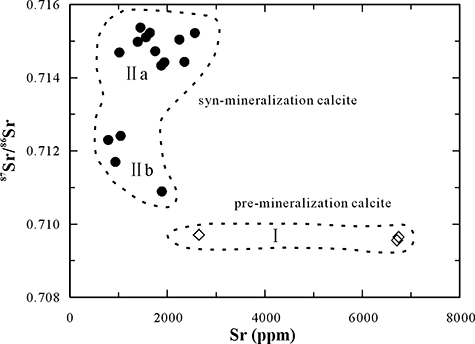
Figure 3. 87Sr/86Sr ratio vs. Sr concentration diagram for the pre- and syn-mineralization calcites from the Xujiashan deposit.
The Xujiashan antimony deposit is hosted by marine carbonates of the Upper Sinian Doushantuo and Dengying Formations in Hubei Province, South China. Our Sr isotopic data from pre- and syn-mineralization calcites that host the mineralization show that the pre-mineralization calcite displays a narrow range of 87Sr/86Sr ratios (0.7096 to 0.7097), similar to the ratios of the Sinian seawater, and high Sr concentrations (2645 to 8174 ppm). In contrast, the syn-mineralization calcite exhibits low Sr concentrations (785 to 2563 ppm) and high 87Sr/86Sr ratios (0.7109 to 0.7154), which is interpreted as the result of addition of radiogenic strontium during the antimony mineralization. The study of Sr isotopes suggests that their Sr component to the pre-mineralization calcite derived directly from the host rocks (i.e. the Sinian marine carbonates), while radiogenic 87Sr for the syn-mineralization calcite derived from the underlying Mesoproterozoic Lengjiaxi Group basement through hydrothermal fluid circulation along the major fault that hosts the mineralization.
The Pb isotopic ratios of stibnite are subdivided into two groups (Group A and Group B), Group A is characterized by higher radiogenic lead, with 206Pb/204Pb = 18.874 to 19.288, 207Pb/204Pb = 15.708 to 15.805, and 208Pb/204Pb = 38.642 to 39.001. Group B shows lower lead isotope ratios (206Pb/204Pb = 17.882 to 18.171, 207Pb/204Pb = 15.555 to 15.686, and 208Pb/204Pb = 37.950 to 38.340). The single-stage model ages of Group A are mainly negative or slightly positive values (-258 to 3 Ma), while those of Group B range from 636 to 392 Ma, with an average of 495 +/- 65 Ma. In addition, there are positive linear correlations among Pb isotopic ratios. These results suggest that the lead of Group A stibnite was mainly derived from the Sinian marine carbonates, and that of Group B stibnite from the underlying Lengjiaxi Group basement. This conclusion is consistent with the results of the Sr isotopes.
These results indicate that the Xujiashan deposit is not syngenetic sedimentary and in situ reworked origin as previously considered. The metal (mainly Sb) of this deposit was not only derived from the Sinian host rocks, but also partly derived from the underlying Mesoproterozoic Lengjiaxi Group basement.
| Publication name |
RESOURCE GEOLOGY Volume: 61 Issue: 1 Pages: 52-62 Published: 2011 |
| Author(s) |
Shen, Neng-Ping; Peng, Jian-Tang; Hu, Rui-Zhong; Liu Shen; Coulson Ian M. |
| Corresponding author |
PENG, Jian-Tang
pengjiantang@vip.gyig.ac.cn
1. Chinese Acad Sci, Inst Geochem, State Key Lab Ore Deposit Geochem, Guiyang 550002, Peoples R China
2. Cent S Univ, Sch Geosci & Infophys, Changsha, Hunan Peoples R China |